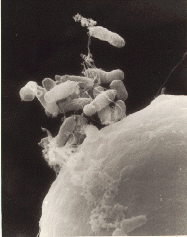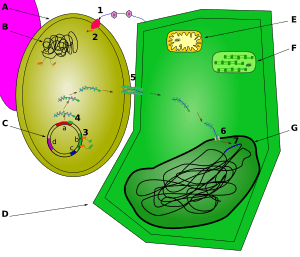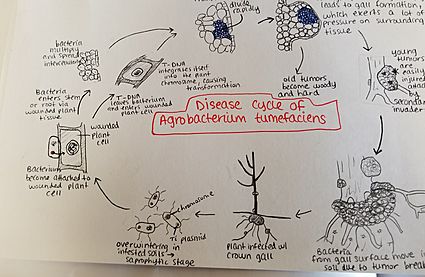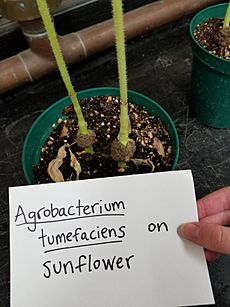Agrobacterium tumefaciens facts for kids
Quick facts for kids Agrobacterium radiobacter |
|
|---|---|
 |
|
| A. radiobacter attaching itself to a carrot cell | |
| Scientific classification | |
| Kingdom: | |
| Phylum: | |
| Class: |
Alphaproteobacteria
|
| Order: |
Hyphomicrobiales
|
| Family: |
Rhizobiaceae
|
| Genus: |
Agrobacterium
|
| Species: |
A. radiobacter
|
| Binomial name | |
| Agrobacterium radiobacter (Beijerinck and van Delden 1902) Conn 1942 (Approved Lists 1980)
|
|
| Type strain | |
| ATCC 23308 B6 |
|
| Synonyms | |
|
|
Agrobacterium radiobacter (also known as Agrobacterium tumefaciens) is a type of bacterium that lives in the soil. It causes a plant disease called crown gall. This disease makes plants grow strange tumours, like bumps or knots, on their stems and roots. Over 140 different kinds of plants, especially eudicots (a large group of flowering plants), can get this disease.
This rod-shaped bacterium is Gram-negative, which is a way scientists classify bacteria. It causes disease by putting a small piece of its own DNA into a plant cell. This piece of DNA, called T-DNA, then becomes part of the plant's own genetic material. This changes how the plant grows, leading to the galls.
A. tumefaciens belongs to the same family as some helpful bacteria that help plants get nitrogen from the air. But unlike those helpful bacteria, A. tumefaciens is a pathogen (something that causes disease) and doesn't help the plant at all. Because it can affect so many different plants, it's a big problem for farmers.
This bacterium is a serious problem for crops like walnuts, grape vines, stone fruits (like peaches and cherries), nut trees, sugar beets, horse radish, and rhubarb. The galls it causes can last a long time, which is especially bad for plants that live for many years.
A. tumefaciens grows best at about 28°C (82°F). If the temperature goes above 30°C (86°F), the bacteria can get "heat shock," which means they don't divide correctly.
Contents
To cause disease, Agrobacterium needs a special piece of plasmid DNA called the Ti plasmid (short for tumor-inducing plasmid). This plasmid contains the T-DNA and all the genes needed to transfer it into a plant cell. Not all Agrobacterium strains have this Ti plasmid.
Bacteria can share plasmids with each other in a process called bacterial conjugation. This is like bacteria "mating" to exchange genetic material. When certain chemicals called opines are present (which are made by infected plants), Agrobacterium produces a signal. This signal tells other Agrobacterium to get ready for conjugation, helping them share the Ti plasmid.
How Agrobacterium Infects Plants
A. tumefaciens infects plants through wounds. It uses its flagella (tiny whip-like tails) to swim through the soil towards plant roots. It's attracted to chemicals like acetosyringone and sugars that leak out of wounded plants. These chemicals tell the bacteria that there's an opening to get inside.
When the bacteria sense these plant chemicals, special proteins on their Ti plasmid, like VirA, get activated. These proteins then turn on other "virulence" (disease-causing) genes. The ChvE protein also helps VirA sense the plant chemicals better.
The bacteria attach to the wounded plant cell in two steps. First, they stick weakly. Then, they make tiny cellulose fibers that strongly anchor them to the plant cell. These fibers also help the bacteria stick to each other, forming small groups.
After attaching, the bacteria make another protein called rhicadhesin, which helps them stick even better.
Here are some plant chemicals that tell Agrobacterium to infect:
- Acetosyringone
- Catechol
- Ferulic acid
- Gallic acid
- p-Hydroxybenzoic acid
- Protocatechuic acid
- Pyrogallic acid
- Resorcylic acid
- Sinapinic acid
- Syringic acid
- Vanillin
Making the T-Pilus
To transfer its T-DNA into the plant cell, A. tumefaciens builds a tiny tube called a T-pilus. When the bacteria detect plant chemicals, they activate 11 genes that are responsible for building this pilus. Think of it like building a tiny straw to suck up DNA.
Transferring T-DNA into the Plant Cell
First, the T-DNA is cut out of the circular Ti plasmid. Special proteins (VirD1/D2) make these cuts. The VirD2 protein stays attached to the T-DNA.
Once the T-DNA is in the plant cell's cytoplasm, it gets covered with other proteins (VirE2). These proteins help protect the T-DNA.
The T-DNA, along with its attached proteins, then travels into the plant cell's nucleus. The nucleus is where the plant's own DNA is stored. Once inside the nucleus, the T-DNA can become a permanent part of the plant's genome.
What the T-DNA Does
Plant Hormones
To create the galls, the T-DNA contains genes that make the plant produce too much of certain growth hormones, like auxin and cytokinin. Plants normally control these hormones very carefully, but with the T-DNA, the hormones are made all the time. This causes the plant cells to grow and divide uncontrollably, forming the large, tumor-like galls.
Opines
The T-DNA also has genes that force the plant to make special chemicals called opines. These opines are like a special food source that only Agrobacterium can use. Most other organisms can't metabolize them. This means the bacteria create their own private food supply inside the plant. For example, A. tumefaciens C58 makes the plant produce a specific opine called nopaline.
Scientists have studied the full genetic makeup of some Agrobacterium strains. For instance, the A. fabrum C58 strain was first found in a cherry tree with crown gall. Its genome has a main circular chromosome, a linear chromosome, and two plasmids. One plasmid, pTiC58, is responsible for causing the disease. The other, pAtC58, helps the bacteria use the opines as food and can be shared with other bacteria. If the pTi plasmid is removed, the bacteria can no longer cause tumors.
How Agrobacterium Helps Science
Scientists have learned a lot from Agrobacterium about how to move genes into plants. Because Agrobacterium naturally puts its T-DNA into plant cells, researchers realized they could use this ability for genetic engineering.
Scientists like Marc Van Montagu and Jeff Schell discovered how Agrobacterium transfers genes. This led to ways to change the bacterium so it could deliver any desired gene into plants. They can put a gene they want into the T-DNA, and then Agrobacterium will carry it into the plant's cells.
For example, scientists have used this method to make plants that glow! They inserted a gene from fireflies that makes light (called luciferase) into plants. This glowing helps scientists study how plant parts like chloroplasts work. It's also used as a "reporter gene" to see if a new gene has been successfully added to a plant.
It's even possible to make transgenic (genetically modified) Arabidopsis thaliana plants by simply dipping their flowers into a liquid containing Agrobacterium. The seeds produced by these flowers will then contain the new genes. Scientists have even managed to transfer T-DNA to human cells in the lab, showing how versatile this method can be.
The way Agrobacterium injects material into plant cells is similar to how some harmful bacteria inject proteins into human cells. This makes Agrobacterium an important area of study for medical research too.
Natural DNA Transfer
Bacteria can naturally take up DNA from their surroundings and add it to their own genome. This is called natural genetic transformation. A. tumefaciens can do this in the soil without any special help from scientists.
The Disease Cycle
Agrobacterium tumefaciens can survive in the soil for many years, even without a host plant. When a host plant is present, the bacteria enter the plant through fresh wounds or natural openings on the roots or stems near the ground. These wounds can be caused by farming tools, grafting, insects, or other injuries.
Once inside the plant, the bacteria cause the surrounding plant tissue to grow too much, leading to gall formation. These galls press on the plant's internal structures, which can block water flow. Young galls are soft and can be invaded by insects or other microorganisms, causing them to decay. When the galls break down, the Agrobacterium bacteria are released back into the soil, ready to infect new plants.
Managing Crown Gall Disease
Controlling crown gall disease involves several methods, mostly focused on prevention.
- Preventative Measures:
* Always clean and sterilize pruning tools to avoid spreading the bacteria to healthy plants. * Inspect new plants from nurseries carefully and don't plant any that show signs of infection. * Avoid planting susceptible plants in areas where crown gall has been a problem. * Be careful not to wound the crowns or roots of plants during planting or cultivation, as wounds are the main entry points for the bacteria. * If you are grafting plants, do it when Agrobacterium is less active. * Controlling root-chewing insects can also help, as they create wounds. * Burn infected plant material instead of composting it, because the bacteria can live in the soil for a long time.
- Biological Control:
* In the past, a common method was to dip seeds or roots in a liquid containing A. radiobacter strain K84. This strain is related to A. tumefaciens but doesn't cause disease. K84 produces a natural antibiotic called agrocin 84, which kills A. tumefaciens. * However, there was a small risk that K84 could transfer its antibiotic resistance gene to the harmful Agrobacterium. So, in the 1990s, scientists created a genetically engineered version called K-1026. This new strain works just as well without the risk of transferring resistance.
Environment and Disease
For any plant disease, three things are important: the host plant, the environment, and the pathogen (the disease-causing organism). Agrobacterium can infect a huge variety of plants, so the environment plays a big role in crown gall disease.
The bacteria need a wound to enter the plant. Things that can wound plants include:
- Farming practices
- Grafting
- Freezing weather
- Cracks from growth
- Insects in the soil
- Other animals damaging the plant
For example, after very cold winters, you might see more crown gall because the cold weather damages plants. Also, tiny worms called nematodes can help Agrobacterium infect plants by damaging the roots and creating entry points.
Temperature is also important. The best temperature for crown gall to form is around 22°C (72°F). If it's much hotter, the bacteria's ability to transfer T-DNA is greatly reduced, meaning fewer tumors will form.
See Also
 In Spanish: Agrobacterium tumefaciens para niños
In Spanish: Agrobacterium tumefaciens para niños





